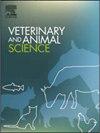研究南非肉牛早期断奶和常规断奶方式下的犊牛生产性能
IF 1.9
Q2 AGRICULTURE, DAIRY & ANIMAL SCIENCE
引用次数: 0
摘要
断奶年龄是肉牛系统的一个关键决定,最终影响生产力和繁殖效率。本试验研究了152对邦smara母牛犊牛在90日龄早期断奶(EW)和205日龄常规断奶(CW)两种不同断奶方式下的生产性能。数据来自南非Vrede地区的Arcadia农田牛群,将初产幼崽的母牛与一组初产和二次产幼崽的母牛进行比较,作为基线比较,反映了南非对幼崽的研究有限。断奶后EW犊牛饲喂生长料和自然放牧,CW犊牛饲喂乳汁和自然放牧。该农场的生产数据表明,连续养殖提高了每头小牛的断奶体重(增加27公斤),突出了生产效益。相反,EW减少了产犊间隔时间(347天和419天),提高了生育力,提高了兽群的繁殖效率,在干旱易发地区具有优势。采用一般线性模型(GLM)评价各生产因素对205日龄犊牛体重的影响。该模型确定断奶实践和产犊重是重要的预测因子。更大的水坝产生更重的小牛,可能是由于更好的母亲条件。这些结果突出了活重增加(CW)和繁殖效率(EW)之间的权衡,强调了在南非牛肉系统中针对具体情况制定断奶策略的必要性。本文章由计算机程序翻译,如有差异,请以英文原文为准。
Investigating cow-calf productive performance under early and conventional weaning practices in south african beef cattle
Weaning age is a critical decision in beef cattle systems, ultimately influencing productivity and reproductive efficiency. This study investigated the productive performance of 152 Bonsmara cow-calf pairs under two distinct weaning practices: Early Weaning (EW) at 90 days and Conventional Weaning (CW) at 205 days. Data were obtained from the Arcadia Farmland cattle herd in the Vrede region of South Africa, comparing primiparous heifers with EW calves to a group of primiparous and second-time calving heifers with CW calves as a baseline comparison, reflecting limited research on EW in South Africa. EW calves received grower meal and natural grazing post-weaning, while CW calves depended on maternal milk and natural grazing. The farm's productive data indicated that CW achieved higher weaning weights per calf (+27 kg), highlighting productivity benefits. Conversely, EW reduced inter-calving periods (347 vs. 419 days), enhanced fertility, and improved herd reproductive efficiency, offering advantages in drought-prone settings. A General Linear Model (GLM) was applied to assess the influence of productive factors on 205-day calf weight. The model identified weaning practice and dam calving weight as significant predictors. Heavier dams produced heavier calves, likely due to better maternal conditions. These results highlight trade-offs between live weight gain (CW) and reproductive efficiency (EW), reinforcing the need for context-specific weaning strategies in South African beef systems.
求助全文
通过发布文献求助,成功后即可免费获取论文全文。
去求助
来源期刊

Veterinary and Animal Science
Veterinary-Veterinary (all)
CiteScore
3.50
自引率
0.00%
发文量
43
审稿时长
47 days
 求助内容:
求助内容: 应助结果提醒方式:
应助结果提醒方式:


